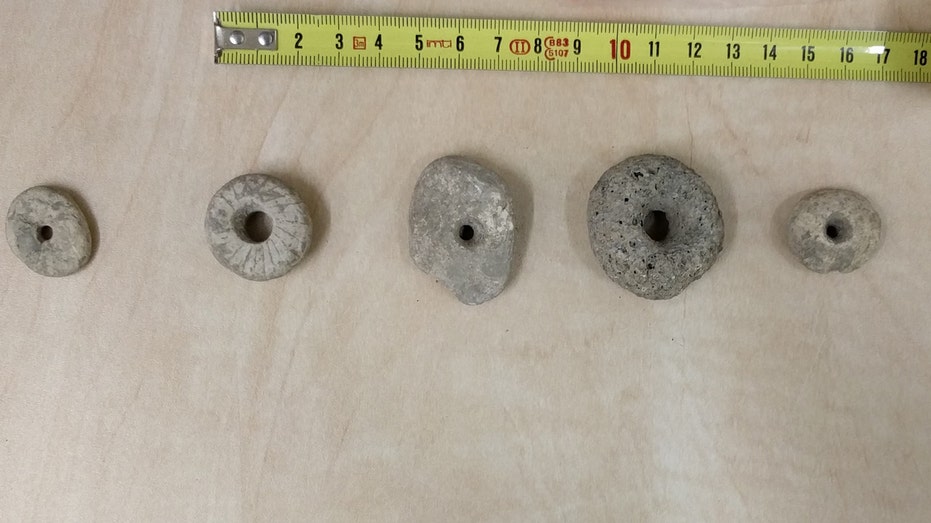
Uncovering Ancient Spinning Technology: A 12,000-Year-Old Discovery in Israel
In a groundbreaking archaeological discovery, researchers have unearthed what may be some of the earliest evidence of spinning technology, dating back 12,000 years. The findings, detailed in a recent study published in *PLOS ONE*, revolve around a collection of perforated stones discovered at the Nahal Ein-Gev II archaeological site in Israel’s fertile Jordan Valley.
A Rich Archaeological Site
The Nahal Ein-Gev II site has yielded significant artifacts over decades of excavation, which began in 1972. To date, a total of 113 perforated stones have been excavated, each adding a unique piece to the puzzle of early human innovation. Among these stones, researchers identified 48 with fully drilled perforations, 36 that were broken with partial holes, and 29 that were left unfinished, showcasing the variety and potential utility of these artifacts.
Examining the Stones
Primarily composed of limestone and weighing between 1 and 34 grams, these small wheel-like artifacts raised intriguing questions about their purpose. While researchers initially considered that the stones might have been fishing tools, a detailed analysis of their shape, material, and the specifications of the drilled holes led to a compelling conclusion: these were likely spindle whorls, tools pivotal in the textile production process for spinning fibers into thread.
The Research Team’s Methodology
The research team, which includes Talia Yasuv and Leore Grosman from the Hebrew University of Jerusalem, utilized advanced 3D modeling techniques to scrutinize the stones. Despite their appearance of variability, the 3D analysis revealed consistent design features. Key findings included:
- Uniform width-to-length ratios across the stones
- Centrally located centers of mass
- Alignment of perforations with the centers of mass
- Consistent minimal width of the holes across the samples
“This analysis revealed that despite outward variability, there are standardized parameters in the design,” Yasuv explained, highlighting the sophistication of these ancient artifacts. However, the researchers acknowledged that a “use wear analysis”—a method to determine how the stones were actually employed—was not included in the scope of the study.
Testing the Hypothesis
To assess the stones’ functionality as spindle whorls, the research team conducted a practical experiment led by Yonit Kristal, an expert in traditional crafts. Initially struggling to use replicas of the perforated stones effectively, Kristal eventually succeeded in spinning both wool and flax, demonstrating the functionality of these ancient tools for textile production.
Interestingly, design characteristics that seemed to hinder spinning at first turned out to enhance the overall utility of the stones. “Surprisingly, design traits that seemed disadvantageous at first turned out to be beneficial for spinning,” Yasuv noted, suggesting that the ancient craftsmen possessed an intuitive understanding of material properties and design.
Broader Implications of the Findings
The implications of this study extend beyond merely identifying the first use of spinning tools. Yasuv emphasized the deeper significance of understanding the evolution of rotational technologies. “The ‘earliest’ spindle whorl could easily become irrelevant when an earlier find is discovered. But our proposed explanation of how this innovation emerged and temporarily disappeared may integrate future discoveries into the larger narrative we’ve developed,” she said.
A Step towards Technological Progress
The researchers concluded that these perforated stones likely served as spindle whorls in the early stages of technological innovation. Viewed within a broader historical context, these artifacts signal an important advance in human ingenuity, representing a critical step towards the eventual development of rotational technologies, including the wheel and axle.
Understanding the Neolithic Transition
In their study, the researchers highlighted the broader relevance of such tools in understanding the Neolithic transition in the Southern Levant, which marks a pivotal period in human history. The emergence of spinning technology and similar innovations played a significant role in the Neolithization process, influencing both technological evolution and cultural development.
Conclusion
The discovery of these 12,000-year-old perforated stones at the Nahal Ein-Gev II site enriches our understanding of ancient human life and technological advancement. As researchers continue to explore these artifacts and their context, our perspective on early human innovation and its impact on the development of civilization will undoubtedly evolve. The significance of spinning technology—rooted in these ancient tools—underscores the complex journey towards modern forms of craftsmanship and societal advancement.


















